Chapter 8 End of Chapter Questions
1/42
There's no tags or description
Looks like no tags are added yet.
Name | Mastery | Learn | Test | Matching | Spaced |
|---|
No study sessions yet.
43 Terms
Knowledge and Comprehension
Briefly describe the components of DNA, and explain its functional relationship to RNA and protein.
DNA consists of 2 alternating strands in a double helix and are composed of
deoxyribose sugars
phosphate groups
nitrogenous bases
Purines
Adenine
Guanine
Pyrimidines
Thymine
Cytosine
held together by hydrogen bonds between nitrogenous bases
Information held in DNA nucleotide sequence = basis for RNA and protein synthesis
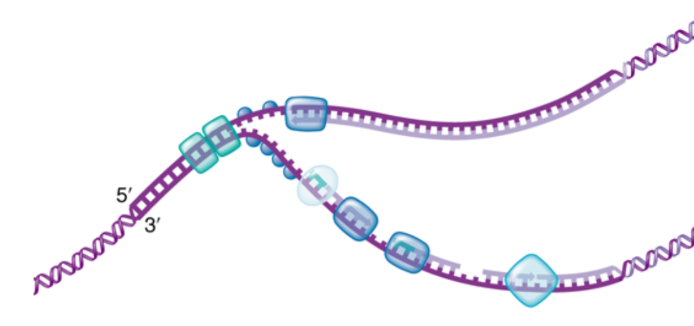
DRAW IT Identify and mark each of the following on the portion of DNA undergoing replication:
replication fork
DNA polymerase
RNA primer
parent strands
leading strand
lagging strand
the direction of replication on each strand
the 5’ end of each strand.
top 5’ end should be of leading strand
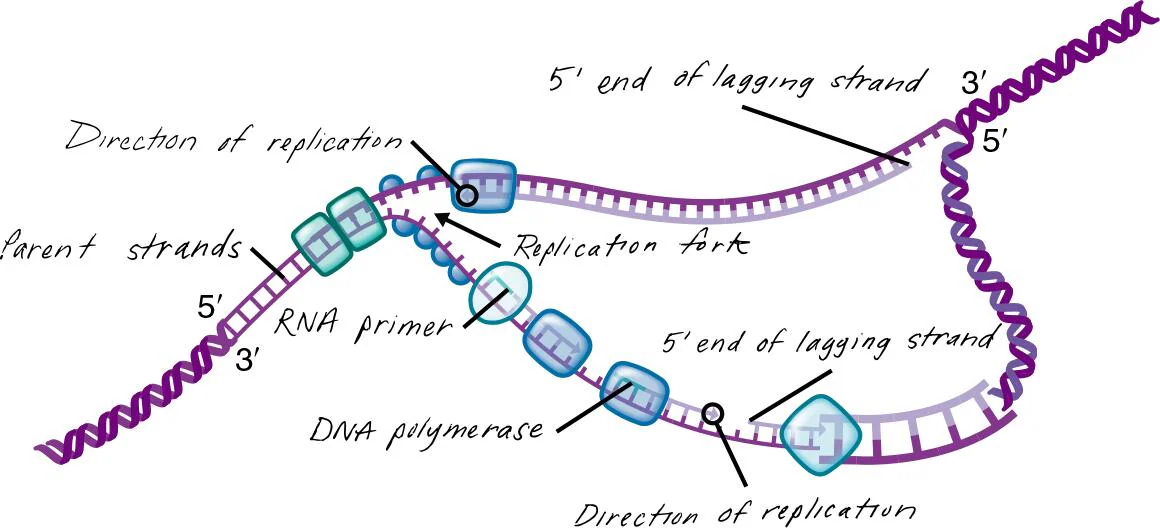
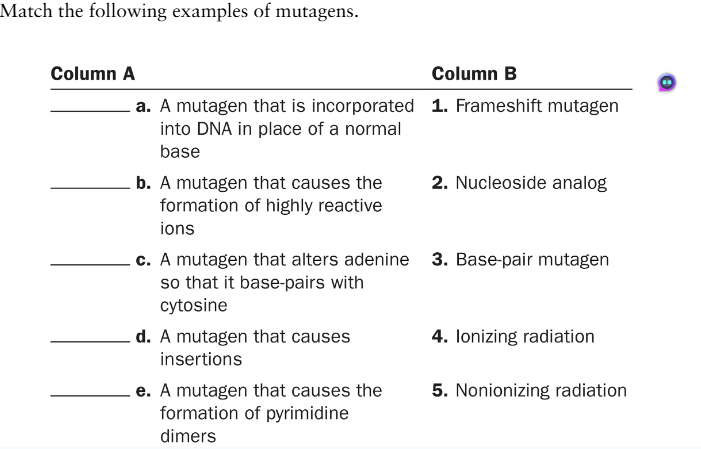
a. 2
b. 4
c. 3
d. 1
e. 5

A. Using the genetic code provided in Figure 8.8, fill in the blanks to complete the segment of DNA shown.
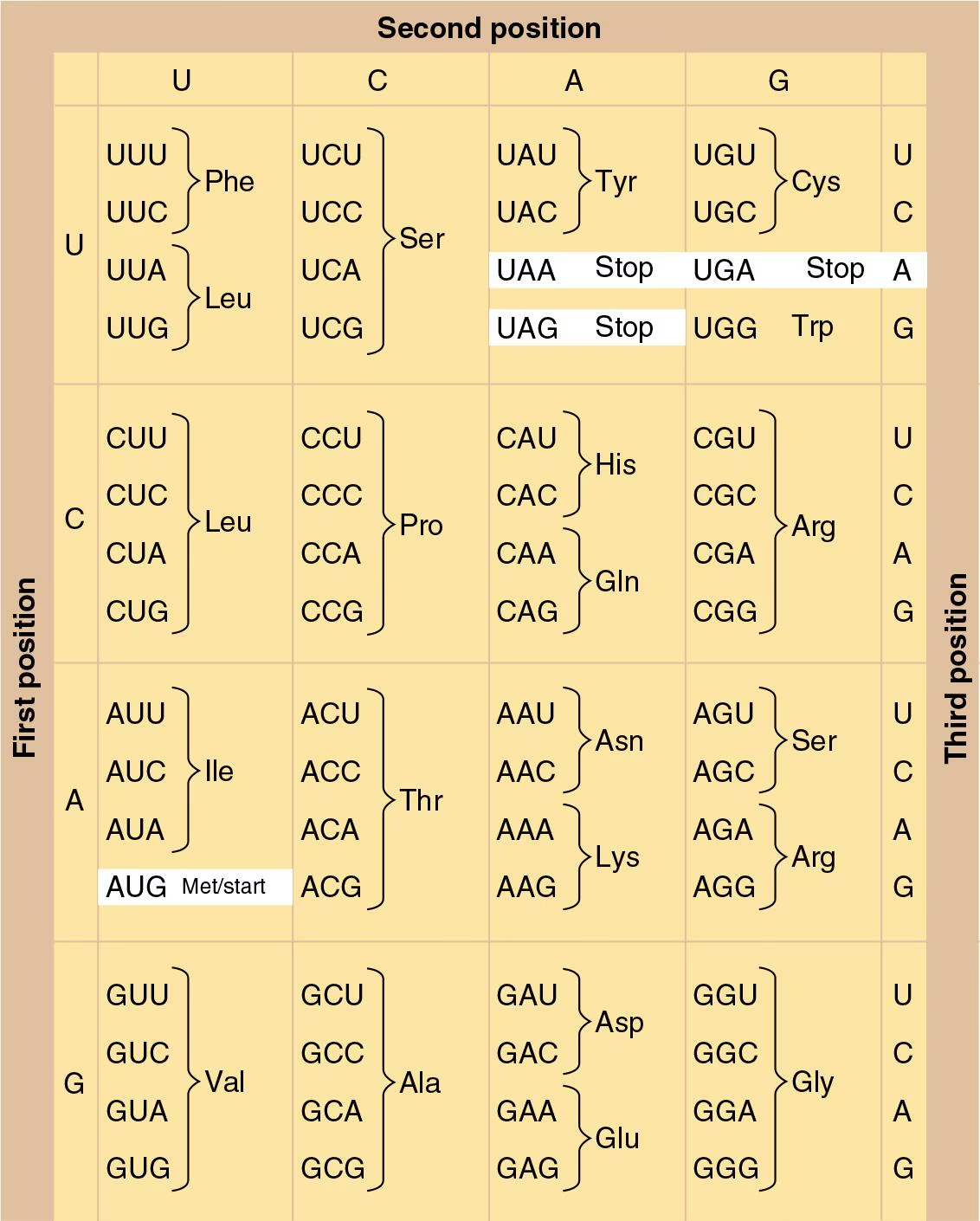
ATATTACTTTGCATGGACT

B. Fill in the blanks to complete the sequence of amino acids coded for by this strand of DNA.

met-lys-arg-thr-(end)

C. Write the code for the complementary strand of DNA completed in part (a).
ATATTACTTTGCATGGACT
TATAATGAAACGTTCCTGA
last 6 should be ACCTGA tho?

D. What would be the effect if C were substituted for T at base 10?
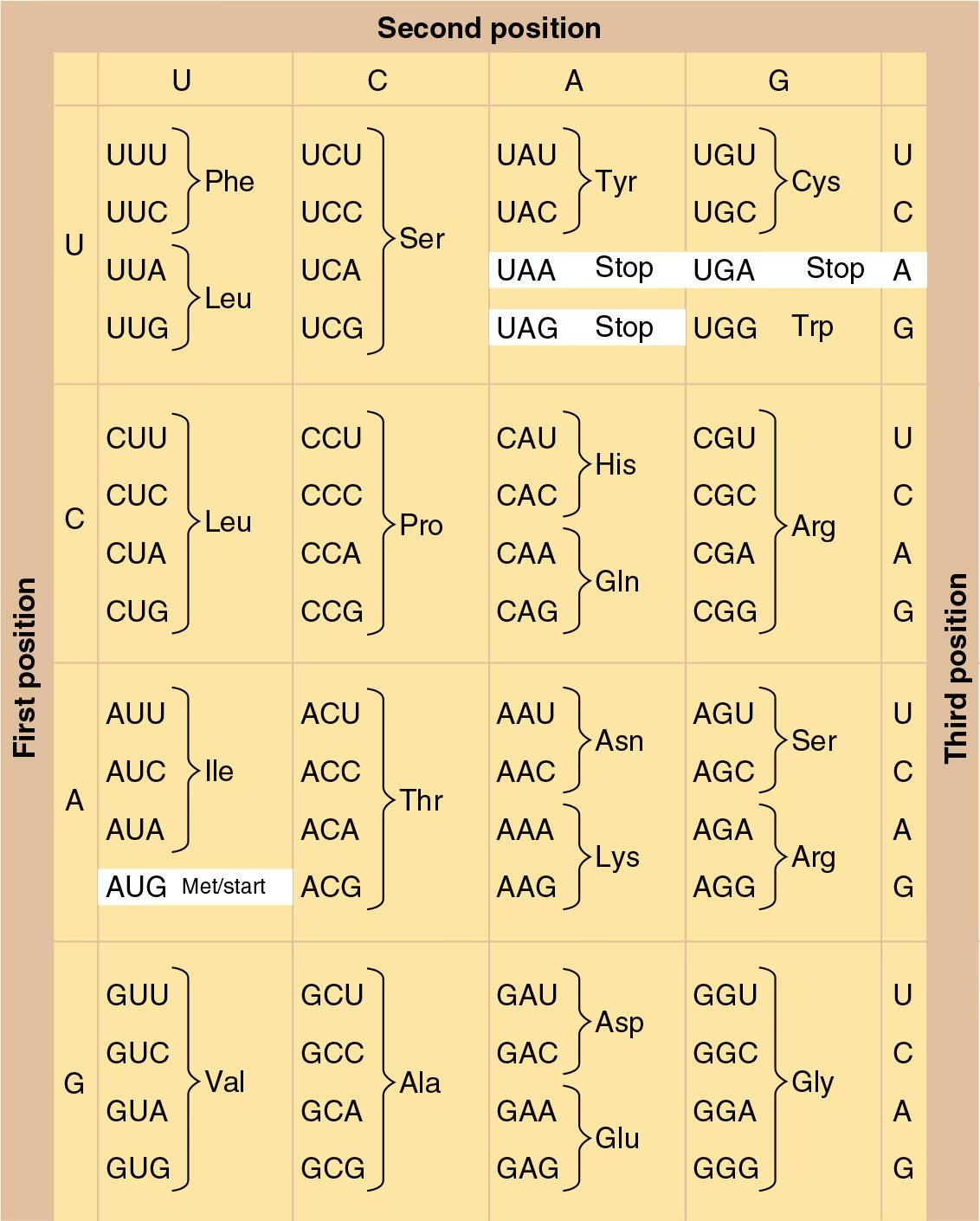
No change, still produces lys at that mRNA codon

E. What would be the effect if A were substituted for G at base 11?
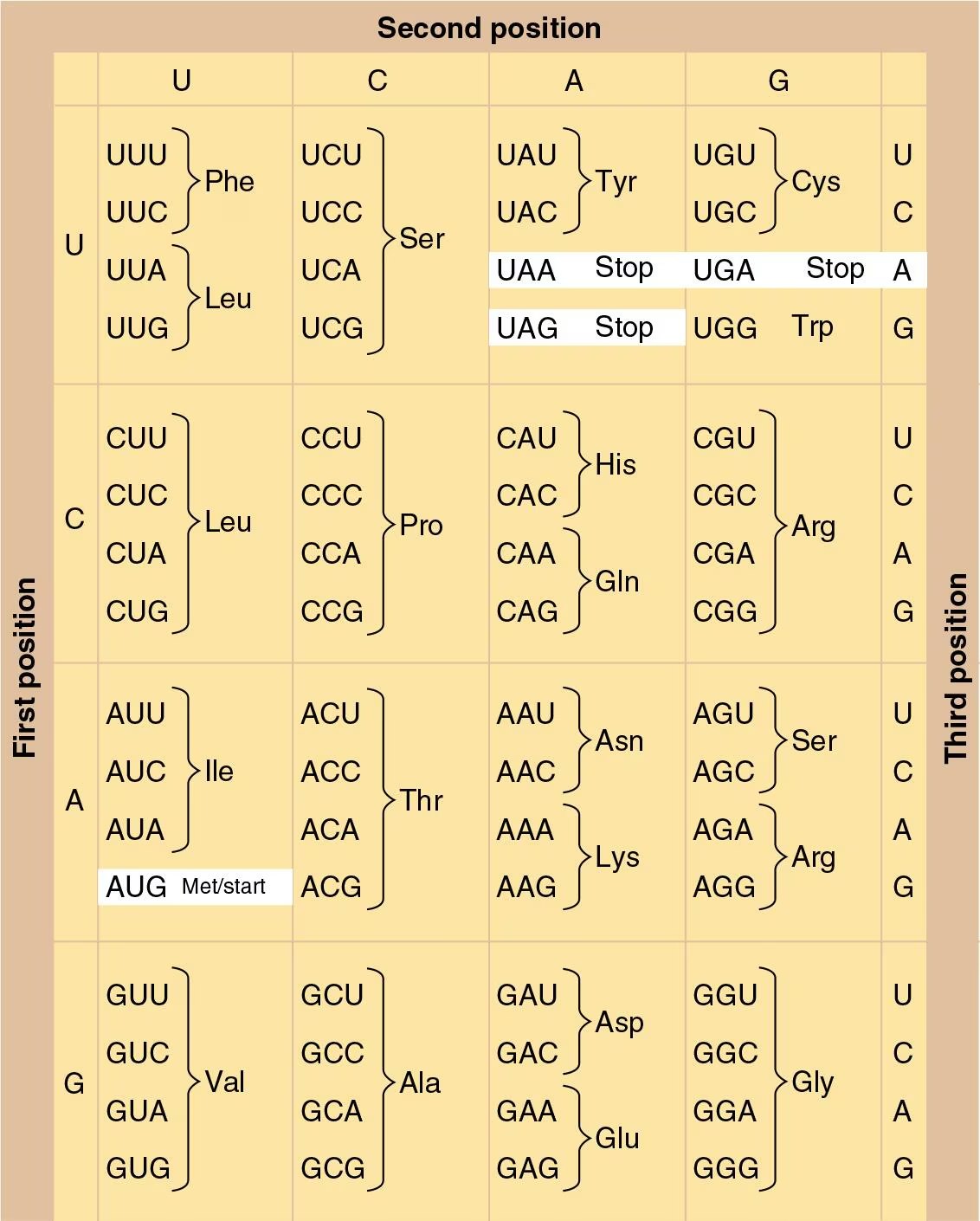
Cysteine substituted for arginine

F. What would be the effect if G were substituted for T at base 14?
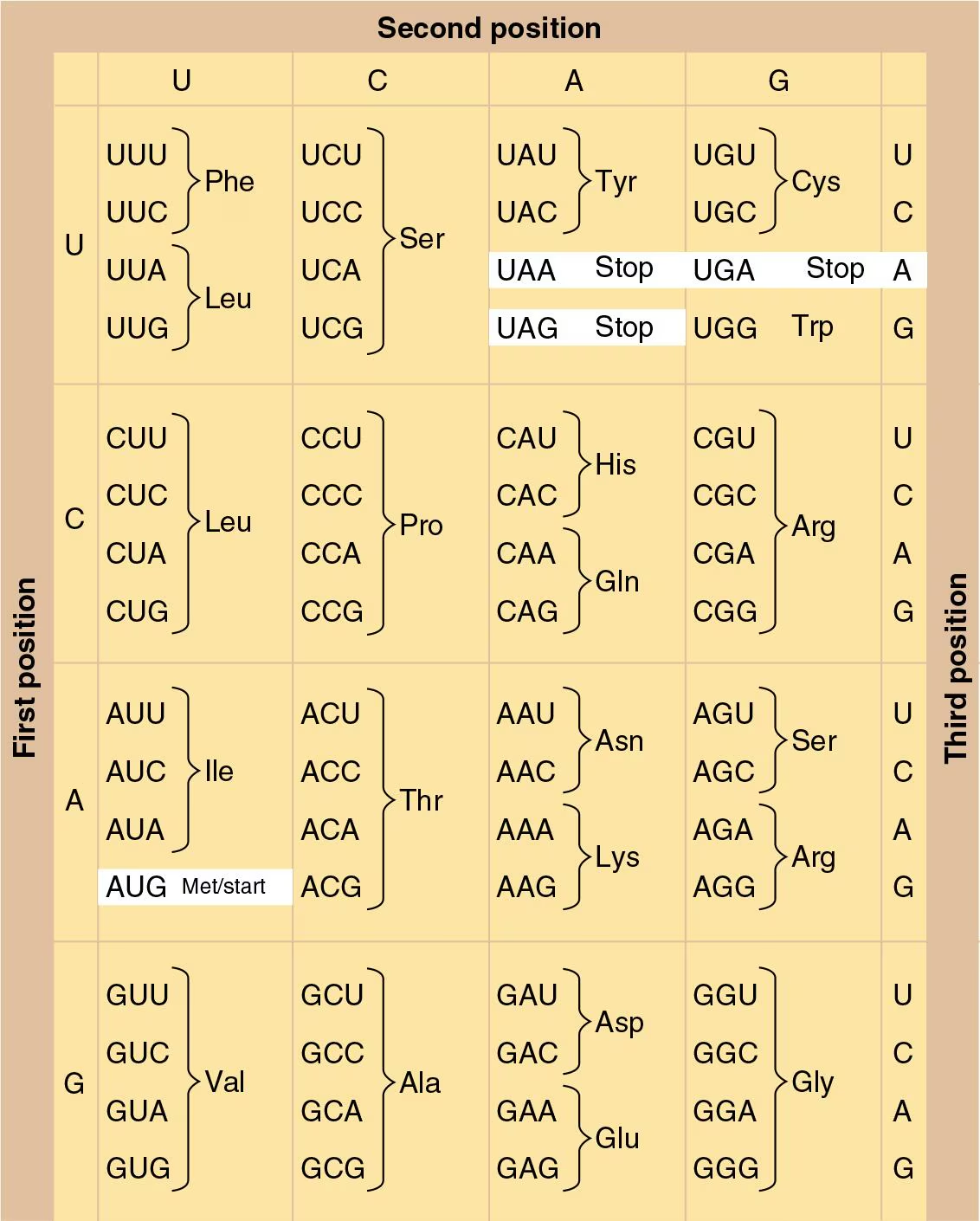
Proline substituted for threonine (missense mutation)

G. What would be the effect if C were inserted between bases 9 and 10?
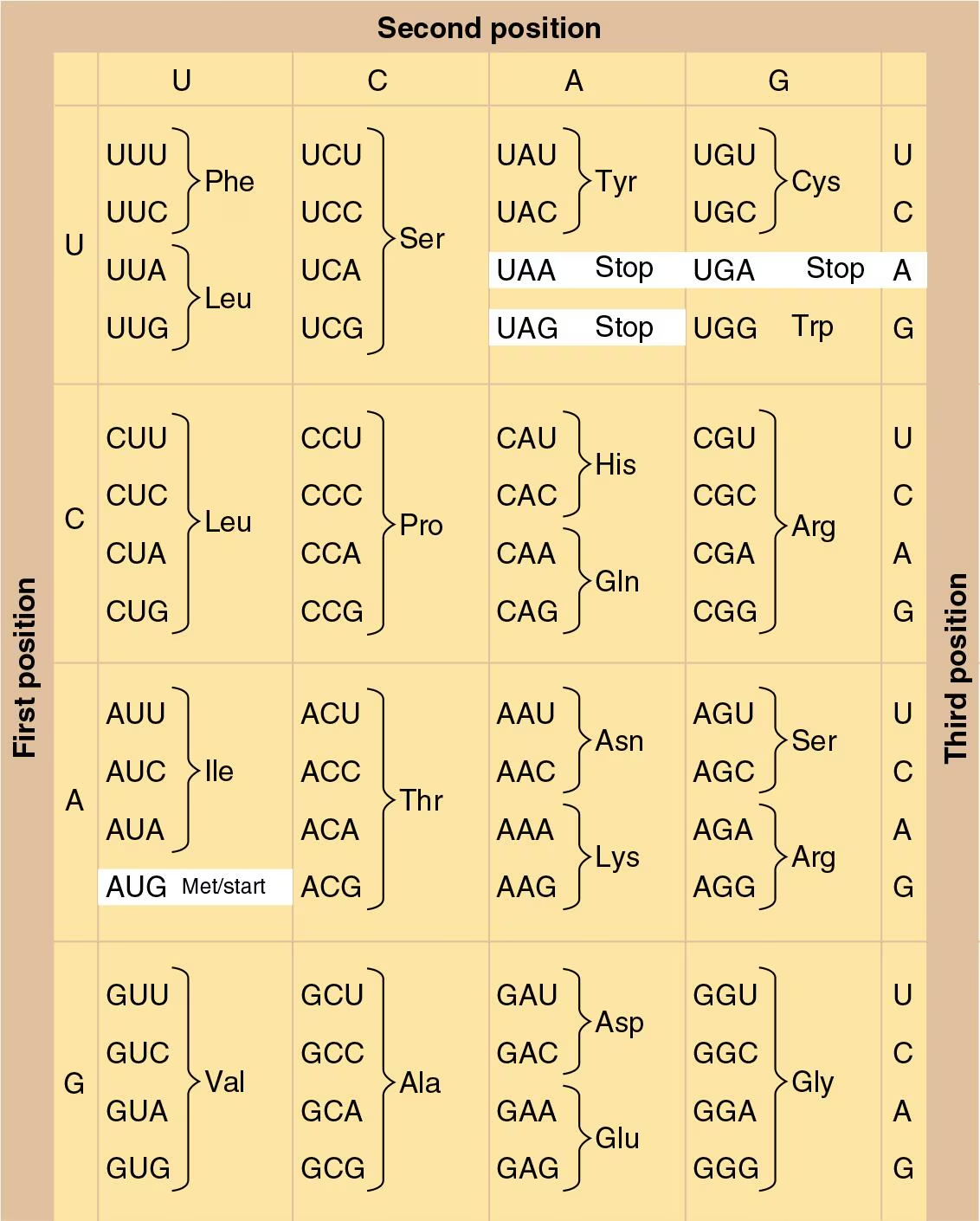
Frameshift mutation
H. How would UV radiation affect this strand of DNA?
Adjacent thymines might polymerize —> thymine dimers

I. Identify a nonsense sequence in this strand of DNA.
ATATTACTTTGCATGGACT
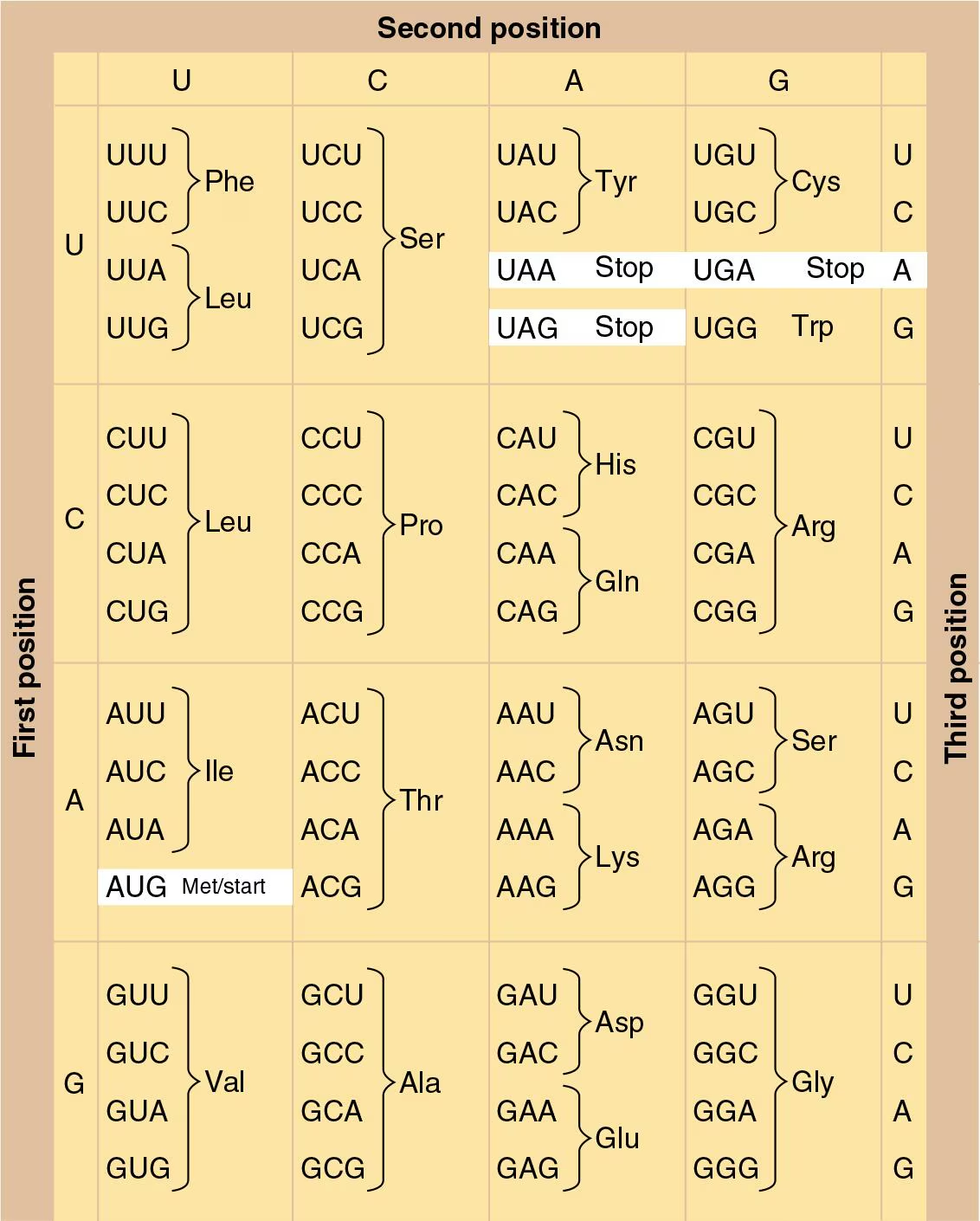
ACT
A "nonsense sequence" in the context of genetics refers to a DNA or RNA sequence that, due to a mutation, results in a premature stop codon, leading to a shortened and potentially non-functional protein. ACT codes for stop according to the mRNA codon table.
When iron is not available, E. coli can stop synthesis of all proteins, such as superoxide dismutase and succinate dehydrogenase, that require iron. Describe a mechanism for this regulation.
Iron deficiency stimulates miRNA (micro RNA, small non-coding RNA molecules that regulate gene expression) to bind to RNA encoding for these iron-requiring proteins and stop their production.
Identify when (before transcription, after transcription but before translation, after translation) each of the following regulatory mechanisms functions.
ATP combines with an enzyme, altering its shape.
A short RNA is synthesized that is complementary to mRNA.
Methylation of DNA occurs.
An inducer combines with a repressor.
After translation
After transcription
Before transcription
Before transcription
Which sequence is the best target for damage by UV radiation: AGGCAA, CTTTGA, or GUAAAU?
CTTTGA
Remember nonionizing radiation works by polymerizing pyrimidine dimers and UV radiation specifically works by causing polymerizing adjacent thymine dimers. Since this strand has more T’s it’s more likely to be affected.
Why aren’t all bacteria killed when they are exposed to sunlight?
Endospores and pigments offer protection against UV radiation. Additionally, repair mechanisms can remove and replace thymine polymers

Indicate the possible genotypes of a recombinant cell resulting from the conjugation of cultures 1 and 2.
Culture 1 will remain the same.
Culture 2 will convert to F+ but still have its original genotype.

Indicate the possible genotypes of a recombinant cell resulting from conjugation of the two cultures after the F+ has become an Hfr cell.
The donor and recipient cells’ DNA can recombine to form combinations of A+ B+ C+ and A- B- C-. If the F plasmid also is transferred, the recipient cell may become F+.
Why are mutation and recombination important in the process of natural selection and the evolution of organisms?
Mutation and recombination provide genetic diversity such as adaptive traits which are necessary for survival and selected for through natural selection. Then the organisms that survive may undergo further genetic change —» evolution
NAME IT Normally a commensal in the human intestine, this bacterium became pathogenic after acquiring a toxin gene from a Shigella bacterium.
Escherichia coli/ E. coli
Multiple Choice
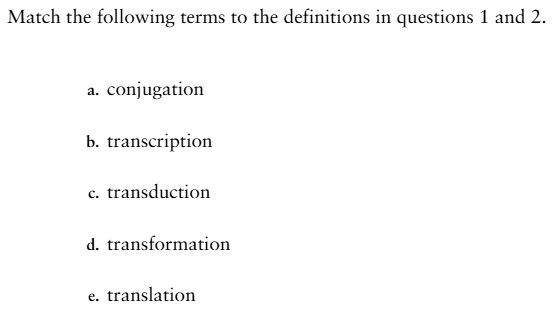
Transfer of DNA from a donor to a recipient cell by a bacteriophage.
3
Side note: Conjugation = The transfer of genetic material from one cell to another involving cell-to-cell contact
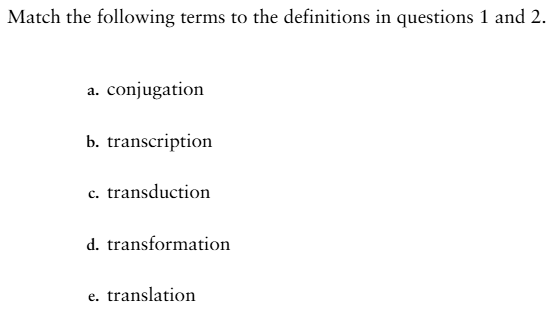
Transfer of DNA from a donor to a recipient as naked DNA in solution.
4
Side note: Conjugation = The transfer of genetic material from one cell to another involving cell-to-cell contact
Feedback inhibition differs from repression because feedback inhibition
is less precise.
is slower acting.
stops the action of preexisting enzymes.
stops the synthesis of new enzymes.
all of the above
3
Bacteria can acquire antibiotic resistance by all of the following except
mutation.
insertion of transposons.
conjugation.
snRNPs.
transformation.
4
Suppose you inoculate three flasks of minimal salts broth with E. coli. Flask A contains glucose. Flask B contains glucose and lactose. Flask C contains lactose. After a few hours of incubation, you test the flasks for the presence of -galactosidase. Which flask(s) do you predict will have this enzyme?
A
B
C
A and B
B and C
3
β-galactosidase is produced when lactose is present, as it is needed to break down lactose into glucose and galactose. In Flask C, lactose is the only sugar available, so β-galactosidase will be produced to metabolize it. In Flask B, both glucose and lactose are present, but since glucose is the preferred energy source, the production of β-galactosidase will initially be repressed through catabolite repression until glucose is depleted, after which lactose metabolism will begin, leading to β-galactosidase production. Flask A will not produce β-galactosidase because glucose alone does not induce the lac operon needed for β-galactosidase production.
Plasmids differ from transposons in that plasmids
become inserted into chromosomes.
are self-replicated outside the chromosome.
move from chromosome to chromosome.
carry genes for antibiotic resistance.
none of the above
2
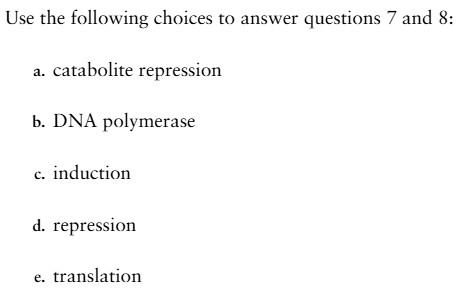
Mechanism by which the presence of glucose inhibits the lac operon.
1
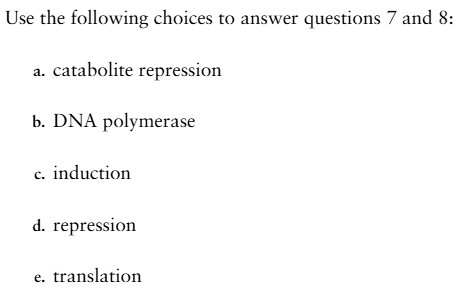
The mechanism by which lactose controls the lac operon.
3
Two offspring cells are most likely to inherit which one of the following from the parent cell?
a change in a nucleotide in mRNA
a change in a nucleotide in tRNA
a change in a nucleotide in rRNA
a change in a nucleotide in DNA
a change in a protein
4
Which of the following is not a method of horizontal gene transfer?
binary fission
conjugation
integration of a transposon
transduction
transformation
1
remember horizontal transfers to the same gen. while vertical transfers to the next gen. which is what happens in binary fission
Analysis
Nucleoside analogs and ionizing radiation are used in treating cancer. These mutagens can cause cancer, so why do you suppose they are used to treat the disease?
Both of these mutagens cause breaks in replicating DNA in mitotic cells (a characteristic of cancer cells). With a large enough # of break, the cell to undergo apoptosis and die. This is a method of using a characteristic of cancer cells to kill them without as much damage to non-cancerous host cells.
Replication of the E. coli chromosome takes 40 to 45 minutes, but the organism has a generation time of 26 minutes. How does the cell have time to make complete chromosomes for each offspring cell?
Generation times can vary and may be more or less than chromosome replication and cell division.
Multifork replication allows new rounds of division to occur before previous rounds complete.
Pseudomonas has a plasmid containing the mer operon, which includes the gene for mercuric reductase. This enzyme catalyzes the reduction of the mercuric ion Hg2+ to the uncharged form of mercury, Hg0. Hg2+ is quite toxic to cells; Hg0 is not.
What do you suppose is the inducer for this operon?
The protein encoded by one of the mer genes binds Hg2+ in the periplasm and brings it into the cell. Why would a cell bring in a toxin?
Mercury ions, Hg2+
It may benefit Pseudomonas, might be required to reduce it
Clinical Applications and Evaluation
Ciprofloxacin, erythromycin, and acyclovir are used to treat microbial infections. Ciprofloxacin inhibits DNA gyrase. Erythromycin binds in front of the A site on the 50S subunit of a ribosome. Acyclovir is a guanine analog.
What steps in protein synthesis are inhibited by each drug?
Ciprofloxacin inhibits transcription > helicase grinds to a halt > can't make mRNA (need to relieve torsional strain resulting from unravelling DNA strands) > no template for protein synthesis
Erythromycin inhibits translation > EF-tu-tRNA-aa complex can't enter A site of ribosome > initiation/elongation can't occur > mRNA cannot be translated
Acyclovir inhibits transcription > acyclovir incorporated into mRNA strand > no phosphate group available on acyclovir to perform attack on incoming nucleotide (in other words no elongation for transcription)
Ciprofloxacin, erythromycin, and acyclovir are used to treat microbial infections. Ciprofloxacin inhibits DNA gyrase. Erythromycin binds in front of the A site on the 50S subunit of a ribosome. Acyclovir is a guanine analog.
Which drug is more effective against bacteria? Why?
Erythromycin because it only targets bacterial ribosomal subunits (odd numbered) and not eukaryotic ribosomal subunits (even numbered).
Ciprofloxacin, erythromycin, and acyclovir are used to treat microbial infections. Ciprofloxacin inhibits DNA gyrase. Erythromycin binds in front of the A site on the 50S subunit of a ribosome. Acyclovir is a guanine analog.
Which drugs will have effects on the host’s cells? Why?
The correct answer is acyclovir because it is a guanine analog that targets viral DNA replication. However, since viruses replicate inside host cells, acyclovir can potentially affect host cells, though it is more selective for infected cells due to viral enzyme activation. Ciprofloxacin and erythromycin target bacterial-specific structures — DNA gyrase (in bacteria) and the 50S ribosomal subunit (in prokaryotes) — which are not present in human cells, so they should not affect the host’s cells. Therefore, only acyclovir is likely to have effects on host cells.
Might just be none of them
Ciprofloxacin, erythromycin, and acyclovir are used to treat microbial infections. Ciprofloxacin inhibits DNA gyrase. Erythromycin binds in front of the A site on the 50S subunit of a ribosome. Acyclovir is a guanine analog.
Use the index to identify the disease for which acyclovir is primarily used.
Why is it more effective than erythromycin for treating this disease?
genital herpes
Acyclovir is an antiviral drug so it’s more effective against viruses while erythromycin is an antibiotic which means it’s geared towards bacterial infections.
false guanine nucleoside - stops protein synthesis and DNA replication?

HIV, the virus that causes AIDS, was isolated from three individuals, and the amino acid sequences for the viral coat were determined.
Of the amino acid sequences shown below, which two of the viruses are most closely related?
How can these amino acid sequences be used to identify the source of a virus?
The answer is A and C they have the practically the same sequence
amino acids are the building blocks of DNA so this is basically the virus’ genetic fingerprint, DNA fingerprinting?

Human herpesvirus-8 (HHV-8) is common in parts of Africa, the Middle East, and the Mediterranean, but is rare elsewhere except in people with AIDS. Genetic analyses indicate that the African strain is not changing, whereas the Western strain is accumulating changes.
Using the portions of the HHV-8 genomes (view image) that encode one of the viral proteins, how similar are these two viruses?
What mechanism can account for the changes?
What disease does HHV-8 cause?
Their mRNA sequences code for 4 out of 7 amino acids in common. The level of similarity between the two** viruses** would require sequence alignment analysis, which is not provided. (2nd part of this answer might be wrong just look at the strands, see the differences, and calculate a percentage maybe)
The genetic changes in the Western strain could result from various mechanisms, including genetic mutations during viral replication (ex: point mutations, insertions, deletions, or recombination events) or exposure to different environments. Mutations may accumulate due to selection pressures or replication errors.
HHV-8, also known as Kaposi's sarcoma-associated herpesvirus (KSHV), is implicated in causing diseases like Kaposi's sarcoma, primary effusion lymphoma, and multicentric Castleman's disease. It is more prevalent in regions like Africa, the Middle East, and the Mediterranean, and becomes problematic especially in** immunocompromised **individuals, like those with AIDS, where the virus can reactivate and lead to severe clinical outcomes.